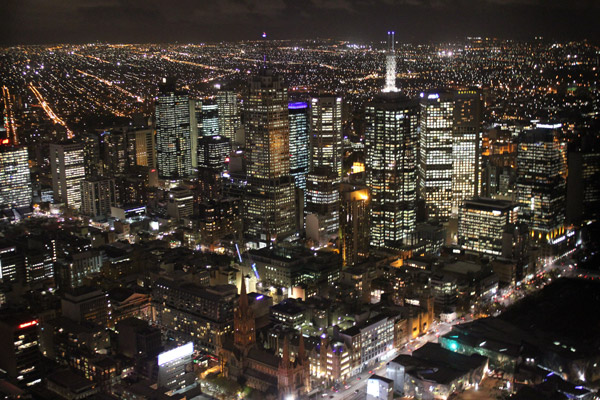Chris & Allyson vs. Australia (May 2012)
Day Eleven: Kangaroos up close. The Dandenongs. The Immigration Museum. A comedy show. Young and Jackson's.
As we woke up in suburban Melbourne on the penultimate day of our Australian adventure, there was no escaping that it was almost over. As full and rewarding as our trip had been to that point, we still had to experience the true essence of Australia before going back to our dreary homeland. There wasn't time to mess around.
So I had Vegemite for breakfast. More accurately, I had a very tiny amount of Vegemite spread on one piece of toast -- which is the recommended dose for non-Australians. Vegemite is a paste made from leftover brewer's yeast, a few vegetables, and the sweat of Tasmanian mine workers. Australians produce a lot of it, because they have lots of leftover brewer's yeast per capita. Ahem.
Since the 1920s, Australia has been engaged in a nationwide science experiment, studying whether an entire population can be socialized to enjoy the consumption of something that objectively tastes awful -- but does not contain alcohol. All signs point to yes. Australians love their Vegemite, which can charitably be described as the food equivalent of rubbing mulch all over your face. It is very dark brown, and it tastes like it looks. It is the kind of staple that you would expect to find in a fallout shelter -- 250 years from now, when you need something to tide you over until the bondage-gear-wearing motorcycle gangs move on to some other part of your post-apocalyptic former homeland, a jar of Vegemite will probably taste about the same as it did at the time of bottling. It couldn't get that much worse.
But if you put it on a sandwich, Australian kids will pound it down, filling themselves with B vitamins and cultural pride. Go figure.
While this genuine international experience was going on, Allyson, Alan and Di were also eating their breakfasts, and in short order everyone was fueled up for another intense, but less bitter, Australian experience. It was time to see kangaroos in the wild.
We had seen kangaroos in a zoo setting, and in plush toy form, and on several thousand signs and logos. But there's something more thrilling about seeing an animal in its natural habitat, where there's the possibility of the animal trying to kill you. And for the record, kangaroos will absolutely kill you if they feel the need. They have hideously strong legs, enormous claws, and powerful tails to balance on whilst eviscerating you with those claws. They don't like it when people discuss politics at the dinner table or insult their favorite sports teams.
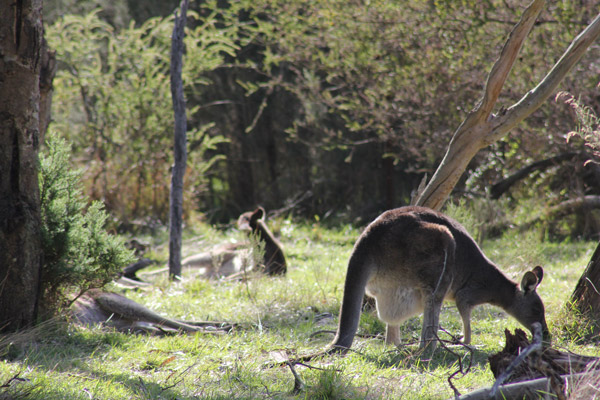
Kangaroos in a suburban Melbourne park.

Hop to it!
The Hees live near a very nice suburban park which features a small lake and some striking woods; it has a well-marked, well-maintained path that's not too strenuous. The whole package has a real forest feel to it, with light peeking through the tall trees and landing gently on losers trying to think up poetic forest imagery. But if you strapped on 2-pound ankle weights and speed-walked the whole thing while listening to Whitney Houston on a Walkman, that would seem OK, too. Vicious Kangaroos dwell in those forests, and if you're lucky, you can spot them. When my parents where in Melbourne with the Hees, they had to visit three times before getting face to face with the mighty creatures.
We were a lot more lucky. Just a few minutes down the path, we came across a mob of the beasts (as a group of kangaroos is called), engaged in their usual mob activity. They were laying around. And not even all that viciously.
As it turns out, kangaroos are not always the dynamic go-getters shown in cartoons and Jerry O'Connell movies. They like to lay still, stare at you to see what's up, and then continue laying still. If you don't run at them, they seem to have a "live and let live" philosophy. At no point did they form a circle and start hissing at us, try to pick off the slowest and weakest of our group, or brandish switchblades while blaring hip-hop music. They weren't even upset about being photographed. Every now and then, one of them would hop off into the distance, which provided the only truly spooky moments of our encounter. Even in a forest with lots of undergrowth, a hopping kangaroo makes almost no noise. Approaching from behind, they could be on top of you in seconds, kicking your skull in before you even knew what was happening. Maybe they know that, and the confidence is what makes them so relaxed. The point is, don't say anything to a kangaroo that you might later regret. Just in case.
The mob had some nice variety. There were some bigger, older males; a few up-and-comers; and moms hauling around joeys. In a few cases, you could see feet or tails poking out of the pouches, or clear bulges where females had one in the oven. Which isn't exactly right, come to think of it -- pouches are somewhere between internal and external. Call it "one in the bun warmer." There might have been a few wallabies mixed in there, to be completely honest, but everything we saw at least looked kangarooish.
To borrow one of Alan's favorite words, it was magical. We had a 10-minute encounter with Australia's national icon and no one was mauled. I liked it; Allyson, who really enjoys any animal that looks good as a plush toy, also made some fond memories.
And we still had time for one last date with the wilds of Australia. Personally, I wanted to capture an aboriginal leprechaun and force him to reveal the secrets of non-linear time. But it turns out they don't exist, so Alan and Di instead escorted us to the Dandenong Ranges.
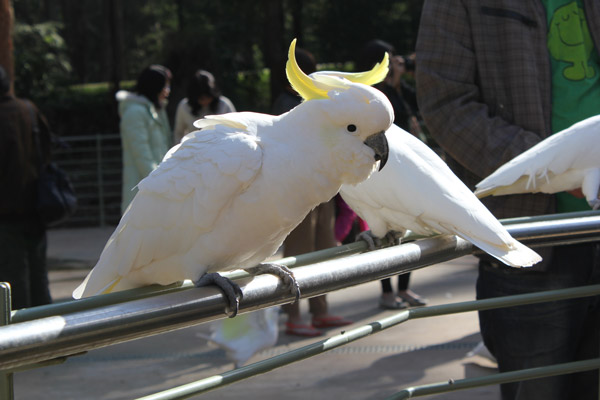
Cockatoos at Grants Picnic Ground.
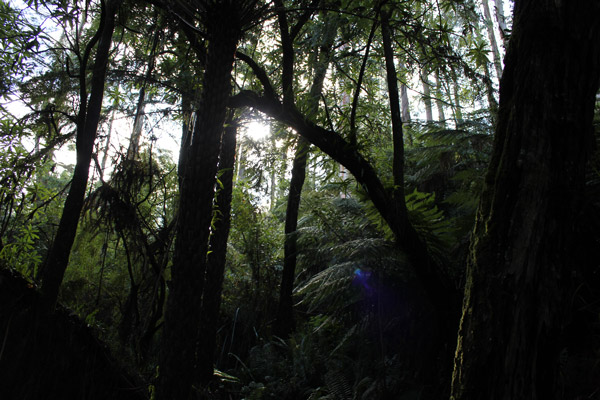
The Sherbrooke Forest in the Dandenongs.
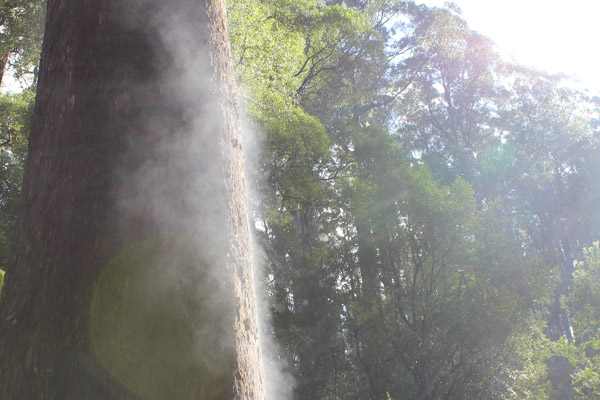
Steam rising off a tree in Sherbrooke Forest.

A kookaburra in the wild.
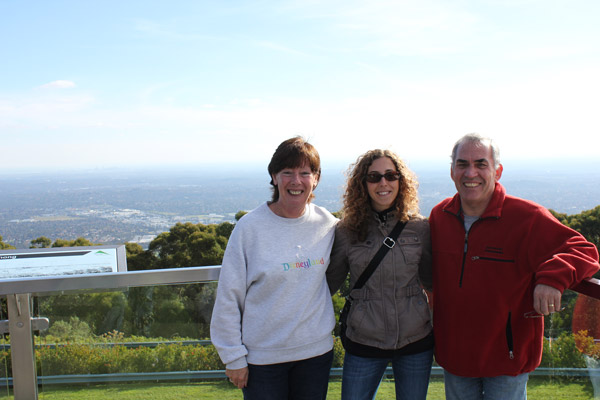
The view from Mt. Dandenong.
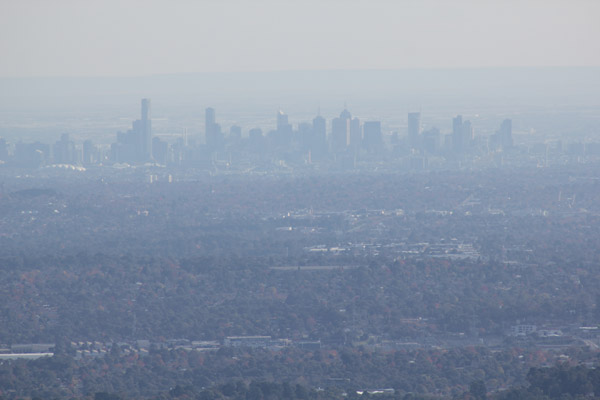
Melbourne, as seen from Mt. Dandenong.
The Dandenongs are to Melbourne what the Blue Mountains are to Sydney. They're not too far from the city, they're dotted with little towns, and the ecosystem is perfect for tourists. It's ideal for urbanites who want to have some intimate moments with nature, but want to get out there fast once nature starts asking about where this relationship is going. We were ultimately headed to the top of Mt. Dandenong and another scenic vista, but we made a few stops along the way.
The first was at Grants Picnic Ground, in the middle of Sherbrooke Forest. It's a popular wayside, and it represented my last, best chance to aggravate my wife by taking more bird pictures. The picnic ground has some "pay to play" bird-feeding areas, where for a nominal fee you can have wild cockatoos and rosellas chomp feed out of your hands. Or, for no fee, you can stand four feet away on the other side of a corral fence and take perfectly decent photos of birds up close with only a minimal risk of being bitten or crapped on. As this will be my last mention of cockatoos, it is important to once again emphasize their beauty, while also driving home that they scream like a bag of 4-year-olds who just found out the truth about Santa. We were fortunate to witness yet another miracle of nature, as one older cockatoo fed an adolescent cockatoo -- by vomiting heartily into its mouth. It's not nearly as beautiful as you're imagining.
We didn't want to miss the trees for the forest, so we also availed ourselves of a trail into the woods. The Sherbrooke Forest is home to many mountain ash trees -- a kind of eucalyptus. They are some of the oldest and tallest trees left on the planet. With the tree tops towering way overhead, the forest floor is ruled by giant ferns. It had rained not too long before our arrival, and the whole forest was in the process of drying out. It led to my personal favorite photograph of the vacation. In the spots where the sunshine made it through to the sodden tree trunks, the water was billowing off the trunks in clouds of vapor -- it looked like the trees were smoking. I don't sell nature photography at craft fairs on the weekends, setting up a booth next to the woman who makes $200 purses out of shards of colored glass and old board-game pieces. But if I did, that would be the image that launched my pathetic little enterprise.
And there were more birds in the forest. Taking a picture at a feeding station is another example of lay-up photography, so it was good to capture a rosella in the wild. As an added bonus, when we were exiting the woods we had a run in with a kookaburra, one of Australia's signature birds. They are squat and dumpy enough to seem like a genetic mistake; they are most famous for their call, which has often been described as a laugh. One of the most famous Australian children's rhymes is about the laughing kookaburra, and as you may recall, Men at Work lost a copyright infringement suit that alleged they stole the tune for the flute riff in "Land Down Under." I swear to you, that bird plaintively warbled the entire guitar solo to "Overkill." Or maybe it was me who did the warbling. Either way, nature was treated to a kick-ass guitar solo that day.
I captured just enough fine photos of these birds and trees by the time Allyson was politely indicating through body language that it was almost time to beat me into a coma with my own camera. So we got back into the car and proceeded to Olinda, just a little further up the mountain. It's a lovely town, and from the looks of it, it was founded in the late 1800s with the exclusive purpose of giving people somewhere to stop for lunch. After some more pleasant conversation over a light meal, we took a brief stroll through some of the artsy-craftsy shops along the main street.
There are apparently international standards on how to operate craft stores in tiny mountain towns, because the shops in Olinda would have worked just fine in West Virginia. They had metalwork garden statues of various animals, and a reasonable selection of hard candy, and some mass-produced dolls and glassware that are meant to look artisanal. There is probably an annual convention of small mountain town craft store owners where these stocking decisions are made, so that Chinese sweatshops can make these things in volumes large enough to drive down the costs. Then, the president of the association gives a presentation on the exciting new technologies that will forever change the future of wooden cutting boards in the shape of local animals. Then, Fog Hat plays in the main ballroom as all of the owners of mountain craft stores from around the globe get drunk and have the one-night extramarital affairs they've been anticipating all year. That's why it's known in the industry as the Mountin' Craft Expo, if you catch my drift.
So, we enjoyed our browsing. And from there it was up to the summit of Mt. Dandenong, for another classic view of Melbourne in the distance. There's other stuff up there, like a fancy restaurant and hedge maze, but we were there only for the view. The local geography is made for this stuff. The coastal plain is really flat, and the mountains pop up pretty suddenly. Once you're at the top, there's nothing blocking your view for miles.
With that crowning experience, the nature portion of our vacation was effectively over. We never did see the Outback, but we have godforsaken deserts in America, so it wasn't a crushing omission. There were still some things we wanted to see in Melbourne proper, and Alan and Di were nice enough to risk rush-hour traffic and drop us back at the Rendezvous hotel after a quick stop back at their house.
But we enjoyed our afternoon with the Hees, and deep down we didn't want it to end. That's why my subconscious mind decided to leave our overnight bags at their house. Allyson might tell you that it was stupidity on my part, but I say it was friendship, plain and simple.
Miraculously, this was the first mistake I had made all trip, if you don't count most of my wardrobe choices as mistakes. When we called the Hees to tell them about my error, they offered to bring the bag back downtown in rush hour, but that seemed pointless -- we had plans to see them on day 12, and they had already been too kind. We could live without a few minor toiletries for a night.
At least, I could. For the dramatic purposes of this story, in which I constantly depict my perfectly lovely wife as a chore of a woman, Allyson was distraught and had to take a nap to escape the madness swirling around her. For the dramatic purposes of this story, In which I constantly seem to be an infallible judge of character, I knew that it was time to give her a little space.
So while Allyson slept off her fury, I hit the streets of Melbourne by myself. I didn't have to walk far to get to a location that Allyson wasn't going to miss seeing. The Immigration Museum is just a few blocks down from the Rendezvous , in a building that used to serve as the Customs House for Melbourne. Its simple mission is to describe the immigrant experience for a nation where no one is that far removed from an immigrant.
I admire their commitment to telling that story, without attempting to replicate the smells of the journeys that brought people to Victoria. They have some interesting personal histories on display, replete with artifacts from the barber shops, restaurants and brothels that various immigrants established. There are rooms set up to replicate the vessels that would have transported immigrants of various degrees of wealth, from the luxury steamer to the steaming turds that passed for the boats used by poor people.
Most interestingly, they have tried to find delicate ways to address an intriguing question: Is Australia racist? You can't get around the fact that Australia was racist. The immigration rules for the first half of the 20th century were known as the "White Australia policy," and if you can spin that in a positive way, then you need to get a high-paying job in marketing immediately. The museum has a copy of the sheet music to the toe-tapping 1910 hit "White Australia," which was surely all the rage at town dances and spontaneous outbreaks of mob violence.
After World War II, things started to loosen up, and there are no longer any major racial restraints on who can move to Australia. But it takes time to unwind most cultural standards, and a common knock on modern Australia is that casual racism runs rampant. A lot of people don't hide their frustration with the aboriginals, for example, and they sling around slurs a little more freely than we're used to in some parts of the United States.
But Australians don't deserve any racism awards. One of the great luxuries of living in an advanced Western society is that you have the freedom to complain about how horrible and backwards your advanced Western society has become. You can single out incidents of racism and condemn your entire culture, because no one is going to shoot you for complaining. The very fact that Australians are having these discussions is a pretty good indication that they're doing fine, in the grand scheme of things. Right now, the nation is collectively in its "All in the Family" phase, where there's mostly superficial racism wrapped around a core of tolerance. If you want some serious, industrial-strength racism, go to China, or Russia, or Korea. Those people are hateful. Every last one of them.
I contemplated all of Australian history while wandering the shopping arcades of downtown Melbourne, but before long it was time to collect my wife. With the anger slept out of her system, she was ready for another adventure into the beating heart of Australian culture. We were going to a comedy club.
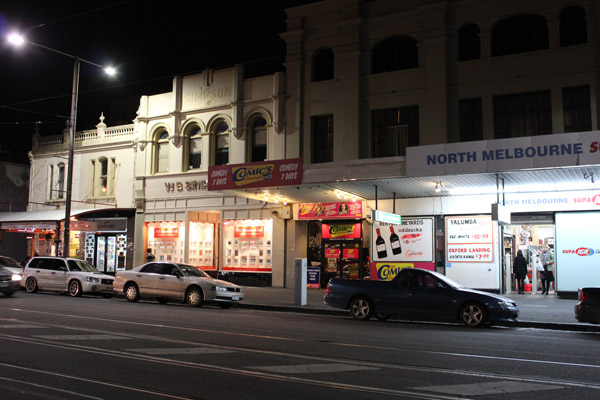
The Comic's Lounge in Melbourne.
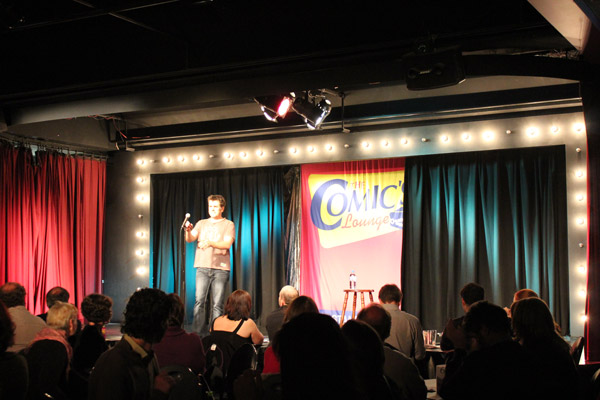
Showtime at the Comic's Lounge.
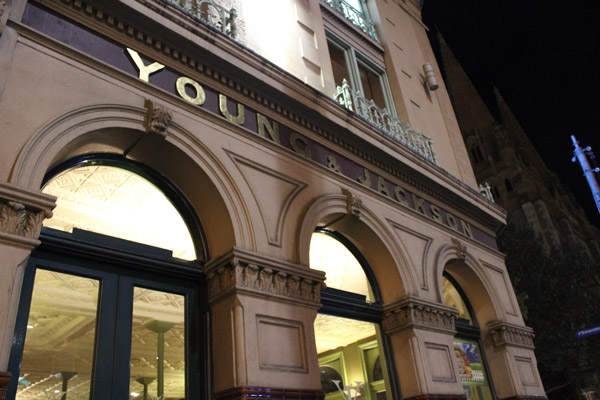
A historic watering hole in downtown Melbourne.
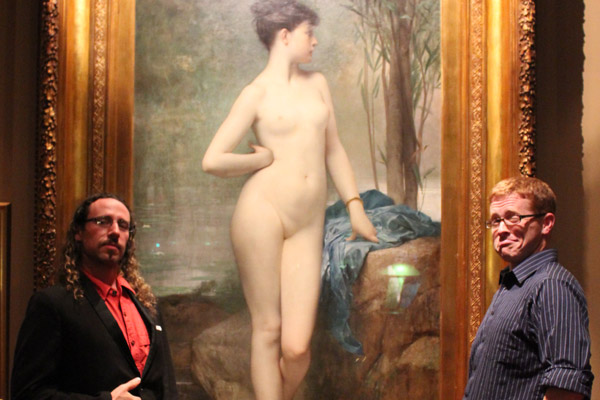
Visiting an old friend and making a new naked friend.
Stand-up comedy could be considered a global phenomenon at this point, but it's an art that has flourished primarily in English-speaking countries. America is the global leader, with Canada, England, Australia, Ireland and New Zealand rounding out the Big Six. Almost every other country that features English as a primary language is a tropical island where people have turned to huge rum drinks and casual sex as their evening entertainment.
Non-English countries have the occasional breakout performer, but most of their oral comedy tradition doesn't jibe with what we think of as modern stand-up; for example, Chinese stand-up always ends with a five-minute self-evaluation in which the performer details ways that their routine could have better served the glorious memory of Chairman Mao. And it is technically impossible to sound funny when speaking German or Japanese, unless you are doing so with the stereotyped cadences and inflections that we have come to expect from cartoon shorts produced during open hostilities with those nations.
Which isn't to say that stand-up is uniform in the Big Six. In each country, it stands to reason that there are nuances as to how comedy is performed and presented to an audience, as well as differences regarding subject matter and overall sensibilities. For us, that was the draw. Allyson and I are students of the comedy arts -- me as a performer, her as the manager of a successful American comedy club. We wanted to see stand-up during our vacation, because it's something we're passionate about, and it's also part of the cultural fabric of Australia. Also, we also enjoy events that allow us to not talk to each other for a few hours.
Melbourne is ostensibly the stand-up capital of Australia. It hosts a major international comedy festival every year, it has a bunch of smaller work-out rooms, and the people there will proudly tell you that it's yet another thing they do better than Sydney.
Surveying the comedy landscape (and a coupon that I found in a guidebook), we decided to go the Comic's Lounge in North Melbourne. We left the Rendezvous at twilight and decided to walk there, in the hopes of seeing the city and finding somewhere to eat. We settled on a place called Le Taj, for two reasons: we were tired of looking; and Indian was one of the few cuisines we hadn't tried in Australia. You can't go all the way to Australia and miss out on the Indian food! Plus, the Le Taj website says that you can "Eat Indian, Feel British, Pay Chinese." You can't go all the way to Australia and miss out on casual stereotyping! The food was fine, but my most treasured memory of that meal is the booze: Firefly is an Australian craft beer allegedly designed to go specifically with spicy food. It combines the self-satisfaction of wine snobbery and food pairing with the socially acceptable practice of drinking straight from the bottle. You can do that with wine, but you're going to get some dirty looks.
Filled with energy and tikka masala, we completed the grueling 1.7-mile walk to the club. We climbed the stairs to the second floor with an open mind, passing the headshots of countless Australian performers we had never heard of. The door guy was surprised to see patrons so early in the evening, and he chatted us up for a few minutes before letting us inside. But we downplayed our ties to comedy, so as not to get any special treatment. This was going to be an authentic cultural experience -- not the ridiculous VIP parade that we usually get as one of the most celebrated entertainment power couples in North America. We ducked off to one of the wings, took our seats and started vibrating with anticipation.
That's when the weirdness began. We came for a comedy show, but we got a glimpse into the fundamental nature of the human soul. And mozzarella sticks.
When we walked into the Comic's Lounge, we were expecting to notice the differences between American and Australian stand-up. Instead, everything seemed eerily the same. The emcee was a decent enough performer, who wanted to let us know that the discount airline used by many Australians is a very cheap company where the flights have a lot of stops. The second guy was an angry older man who was a little vexed that his career hadn't panned out. He felt very strongly that the traffic around the big city sure is horrible. But hey, at least the city is better than that place not too far away, where all of the rednecks live. Those people, if you haven't heard, often have sexual intercourse with close relatives, resulting in offspring of questionable intellect.
You don't need to know the specific airline, or the redneck town, or the highway interchange, or the Australian celebrity that everyone hates. These jokes belong to the universe. Five thousand years from now, when man has established an outpost in another solar system and the Earth has been abandoned as a radioactive husk, people will gather at the spaceport bar for open mic night. A genetically modified 8-foot-tall man with a prehensile tale will take the stage and ask them what's up with the weather lately. He'll then ask them to give it up for the troops, and he'll introduce an angry older man who once had a bit part in a pilot that wasn't picked up.
I reject the notion that the world is small, especially after paying several thousand dollars to sit in a Qantas plane for 12 hours to reach the other side of it. But the human experience is smaller than we'd care to admit, which is both reassuring and terrifying at the same time.
One fundamental insight into the essence of existence seemed to justify the price of admission, so we left at 9:30 -- which by our estimates was about two hours before the end of the showcase. Apparently the Australian spin on comedy shows, at least at the Comic's Lounge, is to make them crushingly long with several intermissions.*
*Also: the service is minimal. They'll come around and take food orders, but if you're getting a drink, a lot of it has to go through the bar -- meaning you have to get up, walk out to the lobby and order from the bar. This goes against the sacred trust of most American comedy clubs. Venues make most of their money on alcohol sales. Audience members want the show to be entertaining, so they are highly motivated to drink. Comedians don't want people wandering through the showroom constantly in search of drinks, because it makes it harder for the audience to focus on the show. So trained professionals who can serve you quietly in the dark take your orders and bring the drinks to you. They work primarily for tips, which are tied directly to quantity of alcohol consumed, so they're motivated to serve you as efficiently as possible -- which means the venue makes more money. It has been this way since settlers built a comedy club in Jamestown in 1611. The Friday late show of the opening weekend was a disaster, as Indians massacred everyone in the smoking section. Yet the system persevered, because it is a very good system. But Australians don't work for tips, so up yours, natural order of things.
Also, we had another appointment to keep. We took a cab back downtown, where we were scheduled to have drinks at Young and Jackson's.
That establishment, at the corner of Flinders and Swanston, has been operating under that name since 1875. It's a stately building, but not a luxurious one; the downstairs is built for heavy drinking, while the upstairs is decorated for more-sophisticated heavy drinking. It seems to cater to a nice balance of locals who like heavy drinking and tourists who like heavy drinking.
We took a seat at "Chloe's bar," which is across from an iconic painting. It has been hanging in Young and Jackson's since before The Great War, and it features a totally nude 19-year-old chick. If you can swing that in a drinking establishment, and make it seem like you're a patron of the fine arts, then more power to you.
More importantly, we were sharing our Chloe time with a good American friend. I first met Justin Butner in my capacity as a trivia host in Washington; he and his friends showed up for enough monthly contests to qualify as regulars, and on top of that they made a point of chatting with me whenever they showed up. We ended up going to a few house parties together and buddying up on occasion. I truly enjoy talking to Justin, because he's a lucid guide to how the other half lives.
If you have to paste a label on the man, Justin could be described as a low-key libertine. He likes to have a good time; he's less worried about traditional social constraints than you are; and he's a little more willing to go where the universe takes him. Interpret that how you will.
The universe took him to Australia in late 2011. He decided to leave his job and live Down Under for a year, because it seemed like a neat thing to do. He did not have steady work lined up, nor did he have a specific travel agenda or a place to stay. He got on a plane, and when he got to Australia, he figured it out as needed.
I couldn't do that, nor do I want to do that. But I admire anyone who can go down that path and make it work. Justin bounced from city to city, working odd jobs when he needed the money; he was part of the cleaning crew at a mining camp in the Outback, and he spent some time as a carnival worker at Luna Park in Sydney. He befriended strangers who took him on trips and gave him places to stay. He bought a used car and slept in it when he had to. When he needed a place to crash in Melbourne, he joined up with the local branch of the Occupy movement and stayed in a park overnight. He romanced some foxy ladies along the way.
We caught up with him six months into his adventure, as he happened to be in Melbourne and staying in a hotel with his visiting mother for a few days. For a man living at the mercy of the universe, he seemed remarkably hale and hearty. We only had a few hours, but it was good to hear the stories of an adventure more adventurous than our own. Again, I personally always want guaranteed access to a flush toilet, but I tip my cap to the Butners of the world.
Fortunately, the toilet we were subletting from the Rendezvous was just a few blocks away, and we departed around midnight to rest up for the dramatic conclusion of our trip. There wasn't much more that we could reasonably expect from Australia. By the end of 11 days, we had spent time with friends from both sides of the world, taken in dozens of scenic views, encountered every animal short of a platypus that appears on an Australian coin, ridden ATVs, gotten drunk, seen art, climbed a bridge, gone hiking, toured museums, sang karaoke and laid in the sun. We had cultural epiphanies, took a lot of pictures and suffered one ear infection.
But on the other hand, who knows when you'll be back that way again? Why not go for it all?
